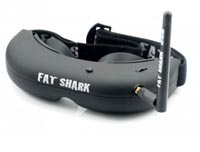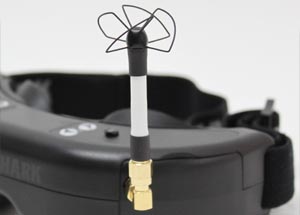FPV Equipment
- Details
- Published on Tuesday, 21 May 2013 18:50
A Variety of equipment is available on the commercial market consisting of both proprietary and opens source components, and some FVP pilots build their own using open source formats such as Arduino etc. This list is not definitive and we will keep adding to it. However, common equipment includes;
 Video Goggles
Video Goggles
Video Goggles are used to give the pilot a full immersive experience. They consist of 2 LCD screens that display the signal being received by the ground station, or the by the receiver built into the goggles. Some goggles also include the option to connect a head tracker to control the camera pan and tilt system, and an audio out to allow the pilot to wear headphones so that he or she can not only see what is going on, but hear it also. This goes along way to giving the full cockpit experience.
Video Transmitter
Small video transmitters are used in frequencies including 2.4GHz, 5.5GHz, 1.2GHz and 900MHz. Power ratings are also varied, from 10mW to 1W systems are commonly used, especially for long distance flying. The use of high gain directional antennas also enable longer flight distances and better video reception.
Video Receiver
Video receivers are situated on the ground (often referred to as the ground station) and are connected to either a set of video goggles or an LCD screen to enable the pilot to view the video being sent from the plane in real time. Some video goggles have the option of including a video receiver for a more compact system.

Antennas
The quality of the video signal really all boils down to a good quality antenna, and the best video transmitter in the world will only be as good as the antenna it is connected to. Different antenna will give different results. For in close flying, standard “rubber ducky” type antenna will do a good job. However, a new “Clover-Leaf” style antenna are becoming very popular due to their ability to deliver a clean signal when the aircraft changes direction, and reducing multi-path interference. A Directional antenna connected to an antenna tracker is used to give far more range the a circular polarised antenna like the Clover-leaf or rubber ducky style.
On Screen Displays
An On Screen Display displays all the key information about your model’s status, and may have many advanced features such as voice alerts, high resolution raster graphics, Return to Home, Artifical Horizon display, Acoustic Variometer, battery voltage and current draw to name a few. Many sensors and their telemetry information is displayed to the pilot in real time in a “Heads-Up” type arrangement, giving the pilot access to vital flight statistics without the need to look away. Some OSDs work in conduction with Antenna Trackers that will point a high gain directional antenna at all times to increase the quality of the signal.
Return To Home
Return To Home is a system implemented in some OSDs that will return the aircraft via an Auto-Pilot back to the point of origin in case of signal loss or by the pilot’s request. It uses sensors onboard the aircraft to automatically fly the aircraft home.
Camera Pan and Tilt Systems
The onboard camera can be mounted on a device that allows the camera to be panned and tilted by the pilot, either by a head tracker, or manually by the pilot. This gives the pilot a far more immersive experience.
Antenna Pan and Tilt Systems
Antenna Pan and Tilt systems have a directional antennas mounted, and along with a tracker system that usually works in conduction with the the OSD, tracks the aircraft and keeps it within the best view of the antenna to maximise the best signal from the video transmitter. The tracker system usually includes a diversity system to enable in close flying without the antenna tracker working overtime to track the plane as it flies past the pilot.
LRS – Long Range System
This is a more powerful radio system that connects to the pilot’s radio control unit that controls the plane, usually on UHF to give the aircraft a far greater range. Distances of over 50km are achievable. Some LRS systems connect directly into the radio such as a module as seen in a Futaba 10C, or connect in via the trainer port as with the Spektrum and JR radios. An accompanying receiver must be installed in the aircraft in order to receive the signal and control the aircraft. Some LRS systems also include Fail-Safes and 2 way telemetry.
Ground Station Recorders
A system where the signal is recorded on the ground to both record the inflight data, and as a fail safe to try and locate the aircraft in case it goes down. Some of these are as simple as an old video camera that can record a “video-in” signal, or the more common digital PVR type recorders.



